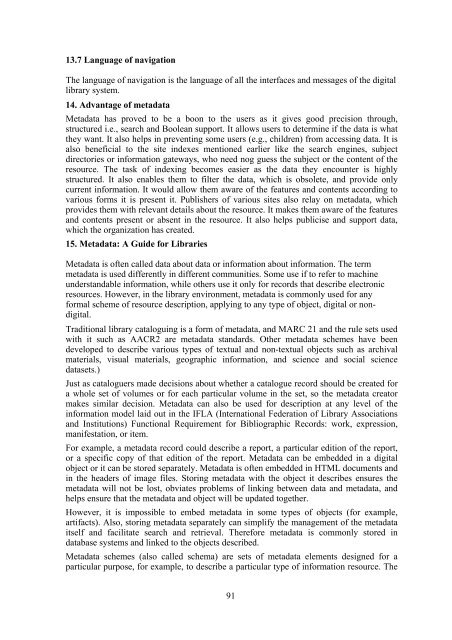7 - Indira Gandhi Centre for Atomic Research
7 - Indira Gandhi Centre for Atomic Research
7 - Indira Gandhi Centre for Atomic Research
You also want an ePaper? Increase the reach of your titles
YUMPU automatically turns print PDFs into web optimized ePapers that Google loves.
13.7 Language of navigation<br />
The language of navigation is the language of all the interfaces and messages of the digital<br />
library system.<br />
14. Advantage of metadata<br />
Metadata has proved to be a boon to the users as it gives good precision through,<br />
structured i.e., search and Boolean support. It allows users to determine if the data is what<br />
they want. It also helps in preventing some users (e.g., children) from accessing data. It is<br />
also beneficial to the site indexes mentioned earlier like the search engines, subject<br />
directories or in<strong>for</strong>mation gateways, who need nog guess the subject or the content of the<br />
resource. The task of indexing becomes easier as the data they encounter is highly<br />
structured. It also enables them to filter the data, which is obsolete, and provide only<br />
current in<strong>for</strong>mation. It would allow them aware of the features and contents according to<br />
various <strong>for</strong>ms it is present it. Publishers of various sites also relay on metadata, which<br />
provides them with relevant details about the resource. It makes them aware of the features<br />
and contents present or absent in the resource. It also helps publicise and support data,<br />
which the organization has created.<br />
15. Metadata: A Guide <strong>for</strong> Libraries<br />
Metadata is often called data about data or in<strong>for</strong>mation about in<strong>for</strong>mation. The term<br />
metadata is used differently in different communities. Some use if to refer to machine<br />
understandable in<strong>for</strong>mation, while others use it only <strong>for</strong> records that describe electronic<br />
resources. However, in the library environment, metadata is commonly used <strong>for</strong> any<br />
<strong>for</strong>mal scheme of resource description, applying to any type of object, digital or nondigital.<br />
Traditional library cataloguing is a <strong>for</strong>m of metadata, and MARC 21 and the rule sets used<br />
with it such as AACR2 are metadata standards. Other metadata schemes have been<br />
developed to describe various types of textual and non-textual objects such as archival<br />
materials, visual materials, geographic in<strong>for</strong>mation, and science and social science<br />
datasets.)<br />
Just as cataloguers made decisions about whether a catalogue record should be created <strong>for</strong><br />
a whole set of volumes or <strong>for</strong> each particular volume in the set, so the metadata creator<br />
makes similar decision. Metadata can also be used <strong>for</strong> description at any level of the<br />
in<strong>for</strong>mation model laid out in the IFLA (International Federation of Library Associations<br />
and Institutions) Functional Requirement <strong>for</strong> Bibliographic Records: work, expression,<br />
manifestation, or item.<br />
For example, a metadata record could describe a report, a particular edition of the report,<br />
or a specific copy of that edition of the report. Metadata can be embedded in a digital<br />
object or it can be stored separately. Metadata is often embedded in HTML documents and<br />
in the headers of image files. Storing metadata with the object it describes ensures the<br />
metadata will not be lost, obviates problems of linking between data and metadata, and<br />
helps ensure that the metadata and object will be updated together.<br />
However, it is impossible to embed metadata in some types of objects (<strong>for</strong> example,<br />
artifacts). Also, storing metadata separately can simplify the management of the metadata<br />
itself and facilitate search and retrieval. There<strong>for</strong>e metadata is commonly stored in<br />
database systems and linked to the objects described.<br />
Metadata schemes (also called schema) are sets of metadata elements designed <strong>for</strong> a<br />
particular purpose, <strong>for</strong> example, to describe a particular type of in<strong>for</strong>mation resource. The<br />
91
















